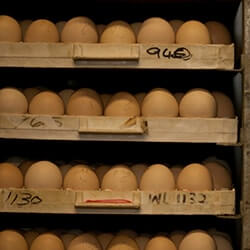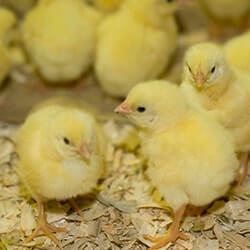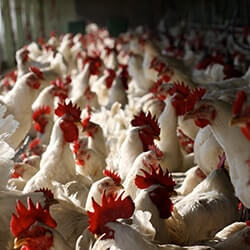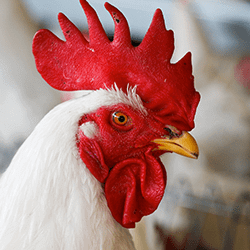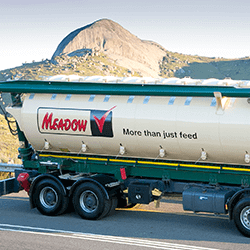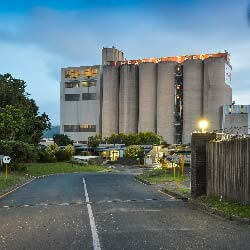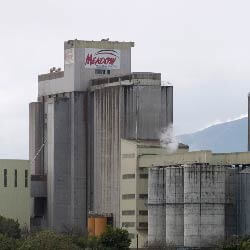Myths / Q&A
Various Myths
Answer) No, definitely not!
No chicken produced by any of Astral's poultry operations are injected, fed or in any way whatsoever subjected to hormones. In order to obtain the desired growth and weight targets, a perfect combination of superior genetics, scientific nutrition and best farming practices are ethically applied. Be assured, eating our chicken products is perfectly safe for you!
Answer) No, not entirely true!
Our fresh chicken, never frozen, is 100% natural. In fact, excess moisture is removed from fresh chicken through an air chilling process before being packed.
However, we do flavour enhance IQF frozen portions (Individually Quick Frozen) with a water based brine, to improve meat tenderness and succulence by means of a scientifically applied injection method.
Answer) Not true at all!
Maize, the main energy source in a chicken's diet, comprises approximately 50% of the feed ration. In addition, specially formulated protein ingredients, together with key vitamins and minerals, are added to create the perfect balanced diet and is fed to our chickens in the form of easily digested crumbles or pellets.
Answer) No, not entirely true!
Antibiotics are administered to our chickens when necessary through feed intake and under the strict guidance of a registered veterinary practitioner. Any incidental antibiotic residues are well within the legislated maximum residual levels (MRL). Astral's standard practice is to withdraw antibiotics from feed according to the manufacturers' guidelines, at least five days prior to slaughter. Astral additionally tests the livers and muscles of slaughtered chickens through an independent laboratory for traces of antibiotic residues.
Antibiotics Myths
Consumers are concerned that antibiotic residues in poultry meat are harmful to their health. In South Africa, legislation stipulates maximum residual levels (MRL) which we at Astral strictly comply with. Simply put, this is about the timeous withdrawal of antibiotics from live chickens prior to slaughter, in order to comply with regulations.
Internationally, it is an accepted practice in poultry production to administer antibiotics for the control and treatment of specific conditions. This humane practice enhances bird health, reduces stress, pain and suffering. In so doing, the consumer is assured of purchasing a safe, quality product.
In essence, antibiotics are naturally produced by micro-organisms to eliminate or inhibit growth of other micro-organisms. Micro-organisms occur naturally, everywhere! That is, in soil, water and in the air, as well as inside of the body (intestines and urinary tract) and on the outside (skin, feathers, hair, etc.) of both animals and man.
On the other hand, antibiotics prescribed for medicinal use are produced commercially in large quantities to be used in the control of bacterial diseases.
The use of antibiotics in South Africa is strictly regulated by the Medicines and Related Substances Act 101 of 1965 and the Fertilizers, Farm Feeds, Agricultural Remedies and Stock Remedies Act 36 of 1947. In Astral, the use of antibiotics is strictly in line with these Acts, with due consideration of the health status of birds; post-mortem analysis by the veterinarian and laboratory testing of bacterial sensitivity to specific antibiotics. This practice ensures that only effective antibiotics are selected and administered.
The correct withdrawal times are always adhered to by feeding a non-medicated ration for at least five days before scheduled slaughtering of the birds. Meat and liver samples from slaughtered chickens are regularly tested for antibiotic MRL as set out in terms of South African law. At Astral, the monitoring of MRL in chicken meat is conducted by independent accredited laboratories.
Cage Myths
Small Wire Cages
At Astral, broiler chickens are reared in large chicken houses, specifically designed to provide ample floor space, comfortable temperature, fresh air, free access to nutritious feed, potable water and suitable light intensity and duration. Broiler houses are either closed (artificially ventilated) or open-sided (naturally ventilated).
Strict hygiene standards are maintained through cleaning of floors and equipment with detergents (soap) followed by disinfection (sanitation) at the end of each production cycle. Bacterial tests are regularly conducted on cleaned floors and equipment to ensure the efficacy of cleaning chemicals and methods. This practice eliminates disease-causing organisms, thereby improving bird health.
The floors in all houses are bedded with good quality wood shavings, sunflower husks or wheat straw which keep the birds dry and warm and enable them to scratch and wallow. The bedding that our chicks are placed on in the houses is turned to prevent excessively wet or uncomfortable conditions.
None of our chickens are ever reared in cages.
Astral fully complies with the broiler production Code of Practice (2004) issued by the South African Poultry Association.
Day-old broiler chicks are placed into large specifically designed houses which are heated to a comfortable temperature. Additionally, the houses are ventilated and temperature-controlled to make sure that our chickens are raised in an optimal environment. This includes free and easy access to safe feed and clean water.
The lighting period is kept longer during the first few days of the birds' life in order to encourage them to eat and drink. Once the chicks have acclimatised to the new environment, lighting is adjusted to enable them to sleep naturally, as they may require.
To ensure that our chickens remain healthy, Astral's team of veterinarians continually monitor and respond appropriately to the health status of our flocks.
Flavour Enhancement Myths
The marination or flavour enhancement of chicken meat through the addition of a brine solution is practiced to improve the tenderness of muscle fibres, and thereby enhance meat quality and taste. Current market trends and consumer demands have led to the acceptance of three dimensions of quality, namely:
Food safety guarantees
Sensory quality i.e. taste (palatability), smell and visual appeal
Nutritional value
These properties are what today's consumers place most emphasis on when defining their preferences in purchasing frozen chicken. Additional attributes that influence consumer satisfaction are those related to texture and consistency, characterised by tenderness and juiciness.
Marination or flavour enhancement refers to the process by which an aqueous solution is added to the meat. The brine solution is mainly composed of water and different ingredients including vegetable extracts, natural flavours and salts. The effect of marination or flavor enhancement is essentially in the moisture retention during cooking ensuring a more succulent and tender product.
It is important to emphasise that excessive flavour enhancement can have a negative impact on meat quality, producing a less acceptable product.
The reason for flavour enhancement is simply to produce a better chicken eating experience! During the slaughter process, chicken meat loses its natural moisture and tenderness. This typically renders the meat dry and tough, especially the breast meat. Hence, the introduction of brine marination technology to overcome the dryness and toughness of the chicken meat. In addition, a quick freezing method ensures that the brine is retained in the meat thereby counteracting the loss of moisture.
Whilst no legislation currently exists that regulates brine enhancement levels in chicken meat, Astral continuously measures the impact of flavor enhancement practice on the quality of our final products. Government and Industry bodies are in discussion in an endeavour to set appropriate industry standards.
Hormone Myths
Astral considers as paramount, the safety of the chicken meat we produce and sell. Many of our customers have expressed concern about the alleged injection of chickens with hormones supposedly to stimulate rapid growth. This is based on their belief that there may be residual hormones in the chicken meat which will have adverse health effects, such as breast cancer and/or uterine cysts in women. However, there are no hormones registered for use in chicken farming for application through injection or feed or any other means, in South Africa. Furthermore, Astral processes about 3.9 million broilers per week which would make the injection of individual chickens with hormones practically impossible!
The myth that hormones are currently used in chicken production stems from historic events in the 1950's in the United States of America (USA) where a synthetic estrogen hormone called diethylstilbestrol (DES) was used to accelerate the growth of chickens and cattle. This in-feed application of DES was linked to an increased risk of cervical and breast cancer. Hence, the in-feed use of DES for food animals was banned during the late 1970's.
Astral's modern breed of meat chickens would not need any man-made hormones to grow faster! These chickens are selected for rapid growth, high breast meat yield and improved feed conversion. This improved production efficiency enables Astral to compete in the market and provide for the ever increasing demand for affordable protein.
It is the balance between superior genetics, nutrition, disease management and the housing environment that came about from many years of scientific research, that has led to the rapid growth of the modern broiler chick.
Maize Myths
Maize is the largest single component of our chicken diet equal to approximately 55% of a typical broiler ration. We provide a perfectly balanced feed mixture which includes other key ingredients such as fish meal, soya meal, sunflower meal, wheat bran and mineral and vitamin premixes.
Maize alone cannot be regarded as a balanced supply of nutrients for any chicken to grow and function in a normal and healthy fashion. Hence, we use a variety of other feed ingredients, in combination with maize, to formulate balanced diets for the various stages of the chicken growth cycle. Typically, commercial broiler chickens will receive up to five different diet formulations during their lifetime.
About 30 different nutrients and combinations of nutrients are routinely included in the specifications of a typical broiler diet. To achieve the required standard, highly trained and specialized poultry nutritionists, use sophisticated computerized software programmes, to determine the nutrient requirements of broiler chickens and formulate the most cost-effective ration from a variety of feed ingredients.
We have technical agreements with several major international companies in the feed and broiler industries that provide the very latest scientific and technical support. Additionally, Astral's investment in a dedicated premix manufacturing plant and an in-house laboratory ensures the quality assurance of ingredients and finished feeds.
Astral's commitment to animal welfare, traceability and feed and food safety, is driven by our application of comprehensive quality assurance systems, including ISO and HACCP.

